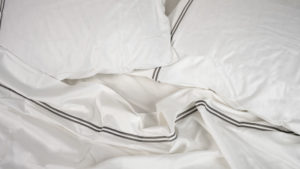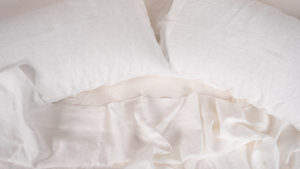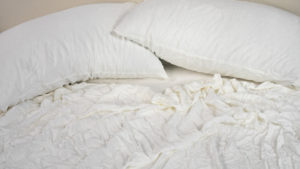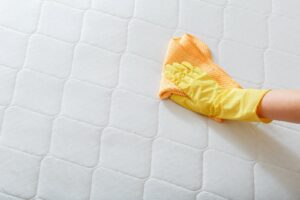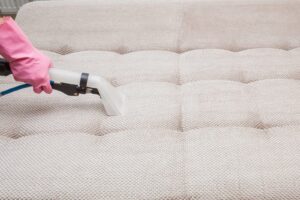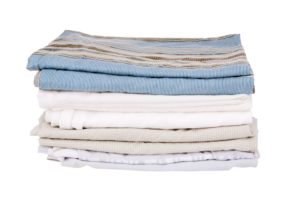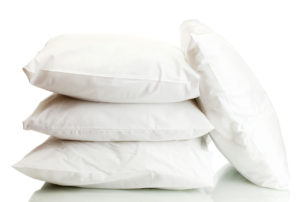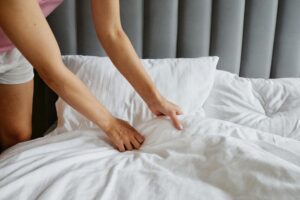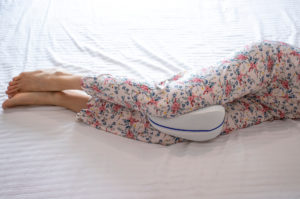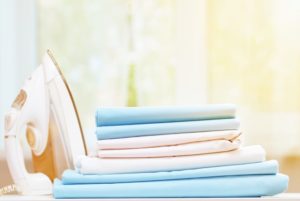Best Material for Bed Sheets
The properties and performance of a sheet are determined by its material and weave. For example, certain types of sheets are breathable and cool, while others tend to be heavy and insulating. Ultimately, the best material for bed sheets depends on each sleeper’s needs and preferences.
While materials like Egyptian cotton and 100% mulberry silk have a reputation for making high-quality sheets, there’s no single best material for all sheets. Instead, the best material is the one that optimally matches your preferences and needs.
Sheets are made from a wide range of fabrics, including cotton, linen, polyester, and bamboo-derived rayon. Additionally, they are woven in a number of different ways. Both the material and weave affect how a sheet feels and functions.
We’ll analyze materials and weaves commonly used in sheets, highlighting properties such as breathability, ability to wick moisture, heat retention, and softness. We’ll also cover standard measurements manufacturers use to describe sheets so you can determine the best sheets for your needs.
Table of Contents
Types of Sheets, Explained
You can find sheets made from a variety of fabrics, and each of these materials meets different needs. Certain fabrics help keep a sleeper cool, and others are made to be warm and insulating. Some materials offer a luxurious feel, while others are appealing due to their low cost. We’ll explore commonly used fabrics in sheets, detailing what type of sleepers they suit.
Cotton
Cotton is the most common fabric used for sheets. Generally speaking, cotton has excellent breathability and moisture-wicking abilities. Additionally, cotton sheets are typically durable and easy to maintain. There is a range of both cotton types and fabric weaves, each with their own properties.
| Types of Cotton | Description |
|---|---|
| Regular Cotton | This cotton is usually found in less expensive sheets. It may also be known as short-staple cotton, which means it is made with shorter cotton fibers. This type of cotton is grown all over the world and generally offers reduced durability and softness compared to higher-end cotton. |
| Pima Cotton | Pima cotton is grown in the United States as well as India, Pakistan, and China. Pima is a high-quality cotton with long-staple fibers that yield breathable, plush, and durable sheets. |
| Supima Cotton | Supima cotton is grown in the United States and meets certain standards for fiber length. Supima’s longer fibers result in a fabric with excellent comfort and durability. |
| Egyptian Cotton | Often considered the highest-end cotton, true Egyptian cotton is handpicked in Egypt. Both the location and the harvesting process yield extra-long fibers for sheets with exceptional softness and breathability. |
| Organic Cotton | Organic cotton has been certified by a reputable agency like the U.S. Department of Agriculture (USDA) as organic. An organic certification usually means the cotton is grown without using genetically modified seeds or chemical pesticides. |
| Weave | Description |
|---|---|
| Percale | A percale weave is achieved with a one-under, one-over weave pattern. This weave allows air to move easily through the sheets, so percale cotton sheets are known for being breathable and crisp to the touch. |
| Sateen | Sateen cotton is woven with a one-under, three- or four-over pattern. This creates a sheet that is smoother and slightly thicker than percale. As a result, sateen sheets offer more warmth and a noticeable sheen. |
| Twill | Sheets made with a twill weave are somewhat uncommon. This weave creates a diagonal pattern in the material that is commonly seen in denim jeans. Twill weave fabrics are often less smooth than other cotton weaves, but they also are more durable. |
| Jersey | Jersey sheets are knitted instead of woven, lending the material a soft and stretchy feel. While this construction method works well for cold weather sheets, jersey sheets may not be as durable as other types of weaves. |
Linen
Linen is derived from the flax plant, which provides long fibers for textiles. As a result, linen is highly durable. Linen sheets offer excellent breathability and moisture-wicking abilities, making them a good choice for sleepers looking for effective temperature regulation.
New linen sheets may be slightly coarse to the touch, but the material softens after multiple washings. Sheets made from linen wrinkle easily, though they can be ironed if you’re looking for a crisp, smooth appearance.
Linen is a good option for those looking for an all-natural, hypoallergenic sheet with great thermal regulation. However, linen sheets tend to be pricier than sheets made with other materials.
Flannel
Flannel sheets are often soft and heavy, offering excellent heat retention. Flannel does not describe a textile’s material origin but rather a process. Creating flannel involves brushing a fabric to increase its thickness and softness, which in turn increases the fabric’s insulating properties.
Although flannel can be made from wool, cotton, or synthetic fibers, most flannel sheets are cotton. Flannel sheets are typically reasonably priced and are a great choice for cooler months or for people who tend to sleep cold at night.
Polyester
The polyester used in most clothing and sheets is a synthetic material made from plastic fibers. Polyester sheets are inexpensive, machine-washable, and relatively resistant to wrinkles.
Sheets made from polyester tend to have poor breathability and may not be ideal for those looking to sleep cool. Because polyester can trap moisture, it may feel unpleasant to some sleepers.
As with clothing, polyester is often blended with cotton to create a smoother feel and better temperature regulation than polyester on its own.
Bamboo
Sheets made from bamboo are rarely made directly from bamboo fibers. Instead, they are made from rayon, a material derived from bamboo pulp via a chemical process.
Bamboo-derived sheets are very soft and offer excellent breathability, making this sheet type a great choice for those who want to sleep cool. The sheets are also fairly durable and offer some stretch.
Bamboo rayon sheets are usually pricier than cotton sheets. Some manufacturers may advertise their bamboo-based sheets as green or sustainable. However, shoppers should note that harsh chemicals are used to process bamboo into rayon.
Silk
Silk is a luxurious fabric that comes from the cocoons of silkworms. Silk is hypoallergenic, and the smooth feel of silk is great for sleepers who prefer extremely soft sheets as well as those with sensitive skin. In addition, silk has excellent temperature regulation and moisture-wicking capabilities.
Silk sheets tend to be more expensive, and caring for them requires following specific instructions to prevent damaging the material. Silk should be washed on the cold delicate cycle and air dried. Even with careful maintenance, silk sheets may wear out faster than sheets made from other materials.
Microfiber
Microfiber is a type of polyester with fine and tightly woven fibers. Microfiber may also be brushed, which lends the material a soft, velvety feel.
Microfiber sheets tend to have an approachable price-point and are a good choice for sleepers wanting a warm and soft sleep surface. Like polyester, microfiber is wrinkle-resistant and easy to clean and maintain.
Microfiber is not as breathable as cotton, so sleepers prone to overheating at night should consider sheets made from other materials. Microfiber sheets are also not a good option for people who value all-natural materials.
Tencel
Tencel is derived from eucalyptus trees. The material is soft, smooth, and durable. It’s also resistant to dust and bacteria. Tencel typically sleeps cool thanks to its excellent moisture-wicking properties.
| Sheet Type | Pros | Cons |
|---|---|---|
| Cotton |
|
|
| Linen |
|
|
| Flannel |
|
|
| Polyester |
|
|
| Bamboo |
|
|
| Silk |
|
|
| Microfiber |
|
|
| Tencel |
|
|
What Thread Count Means
Thread count is a measure of the number of threads per square inch of fabric. Generally, a higher thread count denotes finer thread and a tighter weave, which translates to a softer and more durable sheet.
A higher thread count may reduce breathability, as air cannot pass as easily through tightly woven fabric. In addition, some very high thread counts are a product of using double- or triple-ply threads that do not actually reflect the quality of a sheet set.
Ultimately, thread count is only one factor to consider as you shop for sheets, and this measure alone does not determine a sheet’s quality. Instead, it is important to evaluate thread count along with other elements that affect the performance of bedsheets, including the material type and weave.
Is a Higher Thread Count Better?
While noting a sheet’s thread count is important, shoppers should keep in mind that a higher thread count isn’t always better. Depending on the material, most sheets function best within a certain thread count range.
After a certain point, extra thread count may not convey any additional benefit. For example, a thread count over 600 may not have a noticeable effect on the feel, performance, or durability of the sheets.
Shoppers should also note manufacturers who advertise sheets with thread counts over 900. Manufacturers can manipulate the definition of thread count to boost the number on the packaging. For example, while a weave with double- or triple-ply threads has two or three fibers, the manufacturer counts each thread two to three times, inflating the overall thread count. Manufacturers who employ these tactics may be selling lower-quality sheets.
What Thread Count Should You Look For?
Different materials and weaves have different ideal thread count ranges. For example, cotton sheets tend to have higher thread counts, while sheets made from linen have lower thread counts. Consider these ideal thread count ranges as you shop for sheets.
- Regular cotton: 200-400
- Egyptian cotton: 300-400
- Percale weave: 200-400
- Sateen weave: 300-600
- Twill: 200-500
- Bamboo: 300-500
- Tencel: 300-400
- Linen: 80-140
For linen sheets, the thread count often does not correspond to quality, so many linen sheet manufacturers do not list a thread count.
Grams Per Square Meter
Certain fabrics are measured in grams per square meter, or GSM. The higher a material’s GSM, the denser or thicker a material will be.
Flannel, for example, is often classified according to GSM. One of flannel’s primary characteristics is its warmth, and a flannel’s insulative potential will be directly related to its GSM.
The following list provides ideal GSM ranges for sheets made from various fabrics.
- Linen: 170-190 GSM
- Flannel: 170+ GSM
- Microfiber: 90-120 GSM
- Jersey: 150 GSM
Silk Measurements
Silk fabric is measured in the form of momme. Momme measures the weight in pounds of silk that is 100 yards long by 45 inches wide. Silk may also be measured by denier, which describes the weight of a single fiber. However, it’s not as common to come across the denier unit when shopping for silk sheets.
- Momme: Momme describes the tightness of the weave. The higher the momme, the denser and more durable the silk. Look for silk sheets in the 17 to 22 momme range.
- Denier: Denier measures the weight in grams of a single fiber of silk that is 9,000 meters long. It is not as common for manufacturers to use this measurement.
What Sheets Should You Choose?
There is no single sheet material or weave that will fit everyone’s needs. There are many types of bedsheets available on the market today, making it easy for sleepers to find a sheet that’s best for their needs.
Most Common Best Sheets
The most common material used for sheets is cotton. A big part of cotton’s appeal is that it provides a variety of options at many different price-points. Cotton sheets can be anything from light and breathable to dense and warming. Cotton is also easy to clean and maintain.
Because of the diversity of cotton sheets, it’s important to look closely at the details when considering this type of sheet. Things like the types of cotton, weave, and thread count can provide essential information to help select the best sheets for your bed.
Best Sheets for Hot Sleepers
Hot sleepers should seek out sheets that are light, breathable, and have moisture-wicking properties. Sheets with these properties enable airflow while pulling sweat away from the body to prevent sleepers from overheating.
Sheets made from linen, silk, bamboo-derived rayon, and Tencel are known for their excellent breathability. Cotton sheets with a percale weave can also be airy and light.
Sleepers looking for a fabric that has undergone less chemical processing may find silk or linen meets their needs. Silk offers great temperature regulation, and linen is known as an excellent sheet in warmer weather. However, these types of sheets often come at a higher price-point.
Best Sheets for Cold Sleepers
Cold sleepers should look for heavier sheets that will trap heat and provide a warm, cozy feel. Flannel sheets are well regarded for their warmth, and heavier cotton sheets can help retain heat. Brushed microfiber sheets can also deliver a plush feel that helps hold in body heat.
Cold sleepers should generally avoid bamboo-derived rayon and Tencel options, as sheets made from these materials are generally designed for breathability and cooling.
Best Luxury Sheets
Shoppers looking for luxury sheets should consider Egyptian cotton and silk. Egyptian cotton has a reputation as the highest-quality cotton and yields sheets with superior softness, durability, and breathability.
Additionally, silk can provide an extremely smooth feel against the skin. Silk sheets are lightweight and often used during warmer months, but they can also provide year-round comfort.

Still have questions? Ask our community!
Join our Sleep Care Community — a trusted hub of sleep health professionals, product specialists, and people just like you. Whether you need expert sleep advice for your insomnia or you’re searching for the perfect mattress, we’ve got you covered. Get personalized guidance from the experts who know sleep best.

